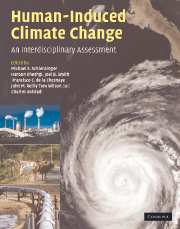Book contents
- Frontmatter
- Contents
- List of contributors
- Preface
- Part I Climate system science
- Part II Impacts and adaptation
- Part III Mitigation of greenhouse gases
- 15 Bottom-up modeling of energy and greenhouse gas emissions: approaches, results, and challenges to inclusion of end-use technologies
- 16 Technology in an integrated assessment model: the potential regional deployment of carbon capture and storage in the context of global CO2 stabilization
- 17 Hydrogen for light-duty vehicles: opportunities and barriers in the United States
- 18 The role of expectations in modeling costs of climate change policies
- 19 A sensitivity analysis of forest carbon sequestration
- 20 Insights from EMF-associated agricultural and forestry greenhouse gas mitigation studies
- 21 Global agricultural land-use data for integrated assessment modeling
- 22 Past, present, and future of non-CO2 gas mitigation analysis
- 23 How (and why) do climate policy costs differ among countries?
- 24 Lessons for mitigation from the foundations of monetary policy in the United States
- Part IV Policy design and decisionmaking under uncertainty
- Index
- Plate section
- References
21 - Global agricultural land-use data for integrated assessment modeling
from Part III - Mitigation of greenhouse gases
Published online by Cambridge University Press: 06 December 2010
- Frontmatter
- Contents
- List of contributors
- Preface
- Part I Climate system science
- Part II Impacts and adaptation
- Part III Mitigation of greenhouse gases
- 15 Bottom-up modeling of energy and greenhouse gas emissions: approaches, results, and challenges to inclusion of end-use technologies
- 16 Technology in an integrated assessment model: the potential regional deployment of carbon capture and storage in the context of global CO2 stabilization
- 17 Hydrogen for light-duty vehicles: opportunities and barriers in the United States
- 18 The role of expectations in modeling costs of climate change policies
- 19 A sensitivity analysis of forest carbon sequestration
- 20 Insights from EMF-associated agricultural and forestry greenhouse gas mitigation studies
- 21 Global agricultural land-use data for integrated assessment modeling
- 22 Past, present, and future of non-CO2 gas mitigation analysis
- 23 How (and why) do climate policy costs differ among countries?
- 24 Lessons for mitigation from the foundations of monetary policy in the United States
- Part IV Policy design and decisionmaking under uncertainty
- Index
- Plate section
- References
Summary
Introduction
Human land-use activities, while extracting natural resources such as food, fresh water, and fiber, have transformed the face of the planet. Such large-scale changes in global land use and land cover can have significant consequences for food production, freshwater supply, forest resources, biodiversity, regional and global climates, the cycling of carbon, nitrogen, phosphorus, etc. In particular, land management and changes in land use can affect fluxes of greenhouse gases including carbon dioxide, nitrous oxide, and methane.
Recently, Hannah et al. (1994) estimated that roughly 50% of the planet's land surface (75% of the habitable area) has been either moderately or severely disturbed; only the core of the tropical rainforests and boreal forests, deserts, and ice-covered surfaces are still relatively untouched by humans. Moreover, Vitousek et al. (1997) estimated that around 40% of the global net primary productivity is being co-opted by humans, while Postel et al. (1996) estimated that over 50% of the available renewable freshwater supply is being co-opted.
The major mode of human land transformation has been through agriculture. Since the invention of agriculture, ~10 000 years ago, humans have modified or transformed the land surface; today, roughly a third of the planet's land surface is being used for growing crops or grazing animals (National Geographic Maps, 2002; Foley et al., 2003).
- Type
- Chapter
- Information
- Human-Induced Climate ChangeAn Interdisciplinary Assessment, pp. 252 - 265Publisher: Cambridge University PressPrint publication year: 2007
References
- 6
- Cited by



